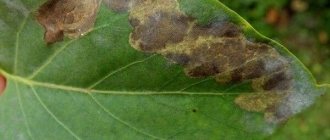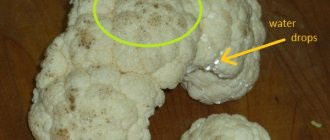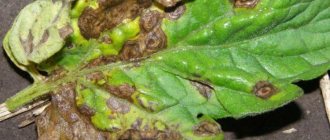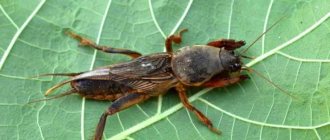The most dangerous sunflower diseases
Almost all sunflower varieties are highly resistant to infection and resistant to most diseases typical for the crop.
Diseases usually develop against the background of poor quality care and non-compliance with agricultural cultivation techniques. Most often, the plant is affected by fungal infections, the causative agent of which can remain in the soil for a long time.
White rot
The most common infection affecting sunflower. The causative agent is a pathogenic fungus of the genus Sclerotinia. When infected, it can destroy up to 65% of the crop, so they try to prevent infection. Signs are more often detected in the second half of summer, but development can continue until autumn. Typical symptoms:
- rotting of seedlings;
- damage to the root collar in young plants;
- the appearance of weeping brown spots, which are gradually covered with a white coating;
- white spots gradually ring the stem, severe damage occurs down to the deep tissues;
- plaque also forms on the seeds. After falling into the ground, they become a source of infection.
You can cope with the disease only in the early stages. For treatment, copper-containing preparations are used, for example, Bordeaux mixture or 1% solution of copper sulfate.
Gray rot
The disease is caused by a fungus of the genus Botrytis cinerea. Active infestations are usually observed in warm weather with frequent precipitation. External signs are similar to white rot, the main difference is the area affected. Brown spots appear on the leaves, over the entire surface of the stem, and also on the basket.
They gradually grow and acquire a rich brown hue. The bush becomes weak and slowly dies. If treatment is not started in time, there is a chance of losing up to 60% of the crop. Chemicals containing copper are used for treatment.
Phomopsis, or gray stem spot
A disease characteristic of sunflower, it is less common in other crops. The peak of infection occurs in the first half of summer. The first signs are observed on the lower leaves. Light brown spots with a whitish border are formed.
Then the infection spreads to the upper parts of the bush and affects the stem. As it develops, gray spots affect the entire plant, and the stem acquires a silvery tint. If the fungus manages to reach the basket, the grains rot and the seeds become hollow.
This leads to significant yield losses and the proportion of products decreases. The disease is difficult to treat; the main method is the use of copper-containing fungicides and Fundazol.
Verticillium wilt
A dangerous fungal disease that is observed from the moment the baskets form until the period of their maturation. It actively spreads through plant debris in the soil; the mycelium can remain in the soil for a long time. Main symptoms:
- the leaves turn pale and lose their elasticity;
- necrotic brown spots with a yellow border appear on all parts of the bush;
- the mycelium affects the root part, disrupting the vascular system;
- the seeds begin to rot and fall off.
The disease quickly affects the entire bush. Treatment is effective only in the early stages of development. To combat wilt, broad-spectrum contact fungicides are used. The treatment is carried out in two stages with an interval of 10-12 days.
Broomrape
A disease typical of sunflower is found everywhere. The degree of damage directly depends on the quality of soil treatment, seeding material and planting care. Broomrape is a parasitic plant that is not capable of processing chlorophyll and has no roots.
It is formed from the root system of sunflower during the period of mass flowering. Initially it resembles a small thread-like process; as it develops, its stem thickens and an inflorescence is formed. Broomrape spreads by seeds and quickly affects even large areas.
It takes away nutrients and water from the sunflower, which leads to a slowdown in its development and a significant reduction in yield.
In addition, the following diseases pose a danger to sunflower:
- true and downy mildew;
- bacterial rot of stems and baskets;
- dry rot of baskets;
- rust.
To avoid crop loss and plant death due to infection, preventive treatment should be carried out in a timely manner, and resistant sunflower varieties should be selected for planting.
White rot or sclerotinia of sunflower
Sclerotinia can be recognized by a white coating formed on the cotyledons, leaves and at the base of the stem, which is especially noticeable on warm and humid days. Further development of White rot is accompanied by a change in the structure and color of the stem (becomes brown), and in later stages, brown-white spots with accumulation of liquid appear on the back of the basket.
Myrtle - home care, beneficial properties of a houseplant
On the plant itself, the disease manifests itself locally, but if it develops at the base of the sunflower, the stem loses its strength and, unable to withstand the weight of the plant, breaks, which leads to the death of the crop. Radical localization is typical for sclerotinia before the flowering period.
The cause of the disease is infected sunflower seeds, wind-borne ascospores, sclerotia in the soil and/or seed. Sclerotia enter the soil along with crop residues. The disease manifests itself clearly during long rains in combination with low average daily temperatures, but weeds in crops can also cause the spread.
You can fight White Rot by covering up the plant remains of sunflowers from last year's sowing and excluding legumes from the crop rotation. Sealing can be done using a heavy toothed harrow, the price of which is reasonable for most farms. Seed treatment and breeding more resistant varieties have proven effective, although it has not yet been possible to achieve 100% plant immunity at the genetic level.
Black spots on a sunflower
Black spot or embellisia is a fungal infection of the foliage, stem, and sometimes the basket of a sunflower. Young plants in the 2-5 leaf phase are most often affected, but already ripening sunflowers are also affected. The disease is contagious, and when it is detected in other countries, quarantine is introduced. Signs of embellisia: black and/or dark brown round or ellipsoidal spots or black small streaks (stripes) protruding first along the edges of the leaves and moving towards the middle, and necrotic cracks form on the spots on the trunk.
The fight against black spot involves treating the seeds before sowing, following agricultural practices and sunflower crop rotation.
Downy mildew (peronospora)
There are 2 forms of development of peronosporosis:
- Typical - sunflower growth continues, but the development of the stem and leaves is significantly inhibited, which leads to their reduction and thinning. A white coating appears on the back of the leaves.
- Atypical - the stems stop growing and thicken significantly, the leaves become corrugated, and the color of the plaque is more pronounced. With the development of peronosporosis, the white coating turns into gray.
Recurrent infection leads to the fact that a white coating gets into the ovaries, causing the embryos to die, so later the sunflower baskets do not bend.
The disease spreads along the stem through the intercellular spaces, and then through the pores of the back side of the leaf blade it appears in the form of that same white coating. The plaque contains zoosporangia. It actively develops in dripping moisture in warm weather (15-18 degrees).
The disease can be controlled by treating the seeds and using fungicides that destroy the spores. In addition, there are sunflower varieties resistant to downy mildew.
Biology
Oospores are the keeper of the infectious principle in conditions unfavorable for the development of the pathogen. They remain viable in soil for 8 years. The source of infection is plant residues, carrion, seeds. In spring, oospores awaken and form mycelium that penetrates plants. The mycelium germinates with zoosporangiophores producing zoosporangia that spread the infection in the spring and summer. Zoosporangia germinate on various plant organs in the presence of drip-liquid moisture in the temperature range from +9°C to +22°C. Optimum - +15°C - +18°C. They swell, and after a while they open and release 8-10 zoospores that can germinate within two hours. At temperatures below 0°C and above + 26°C, zoospores die. Heavy rainfall contributes to the intensive development of the pathogen. Typical forms of the disease with the manifestation of all symptoms are formed during infection through the root system at various stages of seedling development before the formation of cotyledon leaves on the soil surface. When infected during the period from the opening of the cotyledons to the formation of the first pair of true leaves, it leads to the formation of hidden, asymptomatic forms. (Lukomets V.M., 2008) (Lukomets V.M., 2011)
Sand slugger
Sand worms are especially dangerous during the period when the first shoots appear.
The beetles eat young leaves and gnaw through the cotyledons. They feed on many cultivated plants: cereals, oilseeds, legumes, flax seeds, sugar beets. Larvae
feed on roots and underground parts of the stem. They are dangerous only for young plants.
The beetles overwinter deep in the soil, appearing on its surface in early spring. Nutrition is entirely determined by air temperature. At +17, insects eat exclusively plant debris, and as the temperature rises, they begin to destroy healthy cultivated plantings.
To reduce the population, lime and alkaline fertilizers are added to the soil. Effective loosening of rows and destruction of weeds. But the best prevention is treating the seeds with a Fentiuram suspension (65%). This drug repels beetles from seeds placed in the ground.
Read also: Sedum - planting and care in the garden, the use of prominent, caustic, purple, ground cover, false sedum in garden design, photo, video
Verticillium
In the early stages, verticillium can be recognized only during the flowering period of the plant - there is a local lack of turgor between the leaf veins, which leads to tissue necrosis. The affected leaf dries out but does not fall off, becoming a source of infection for the entire plant. With further development, verticillium spores block the conducting vessels of the stem, resulting in poor development of generative organs.
The disease affects sunflower through the root system and spreads through the vessels to the rest of the plant. It develops quickly in the heat, combined with low air humidity.
The main source of verticillium is crop residues, where the mycelium of the fungus develops, but it can also remain in the soil or seed itself. The risk of disease can be reduced by maintaining crop rotation.
Field bugs
Field bugs are quite common pests that feed on the sap of garden and field crops.
Eggs are laid by females in the fleshy parts of plants: leaf petioles, shoot tips. In sunflower, the inflorescence basket is affected. The hatched larvae eat away young seeds and the bases of inflorescences. Damaged baskets become deformed. Bed bugs overwinter under plant debris.
To reduce the population, timely harvesting and burning of stems is used. Deep plowing helps a lot. For spraying, Actellik (50%), Karate (5%) or BI-58 (40%) is used.
If you notice that your indoor plants are stunted, take a look at the roots - perhaps root aphids have settled on your pets. How to destroy it, read this article.
The most common types of ratchets are lily, onion and asparagus. Read what these leaf beetles eat at https://stopvreditel.ru/rastenij/selxoz/treshhalki.html link.
All about cultural diseases and treatment methods
Diseases to which sunflower is susceptible include:
Rhizopus
Dry rot of sunflower (Rhizopus arrhizus) - Rhizopus on sunflower is caused by fungi of the Rhizopus species. The characteristic features of the disease are:
- manifestation at the vegetative stage of development;
- dark spots covering the plant basket;
- an increase in the affected area of sunflower with the transition of infected areas from rotting to drying;
- the resistance of the fungus to climatic conditions, which is the reason for the secondary appearance of the disease in the spring.
Sunflower diseases
Rhizopus are prevented through prophylaxis. The Rhizopus fungus is carried by insect pests that are sensitive to insecticidal effects. A necessary measure will be to eliminate the remains of the infected crop in the autumn.
Sunflower rust
Sunflower rust is caused by the fungus Puccinia helianthi (class Basidiomycetes). The disease is characterized by the following symptoms:
- the first manifestations occur during the vegetative period;
- orange spots on the tops of leaves at the beginning of the development of the disease;
- pustules with spores that form on the plant basket and gradually change their color from light red to dark;
- infection spores remain in the soil layer, which provokes a repeated cycle of the disease.
Measures to combat rust on sunflower involve the destruction of vector weeds using chemical treatment, as well as planting varieties resistant to the pathogen.
This disease reduces the yield of annual sunflower by 37%. Loss of oiliness due to rust is 9%.
Sunflower rust
Gray rot of sunflower
The causative agent of the disease is the fungus Botryotinia fuckeliana (de Bary) Whetzel. The defining features of the disease are:
- damage in the form of a white coating of the entire above-ground part of the plant during the growing season;
- formation of putrefactive spots on the back of the basket;
- covering the sunflower seed with gray color with subsequent loss of suitability;
- The optimal temperature regime for pathogen development is 16°C-26°C.
Effective treatment requires a complex of agrotechnical and chemical measures:
- heat treatment of seeds;
- the use of fertilizers saturated with phosphorus and calcium cyanamide;
- weed control;
- burning of post-harvest residues;
- soil treatment with biological products.
Gray rot of sunflower
Gray mold can cause significant crop loss. The disease has the greatest impact on sunflower in wet weather with high humidity.
Downy mildew
Another name for this disease is periporosis. The cause is the fungus Plasmopara, and the symptoms that reveal the presence of the pathogen are:
- significant slowdown in growth;
- poorly developed stems and root system;
- the formation of a white coating on the bottom of the sheets;
- covering the back of the basket with green spots.
The disease should be combated by timely prevention:
- sowing according to the rules of crop rotation;
- use of varieties resistant to disease;
- treating the area sown with sunflower with herbicides.
Downy mildew
The consequence of infection activity is the loss of up to 35% of the annual sunflower yield.
Phoma sunflower
The pathogen is provoked, depending on the area of distribution, by the fungi Phoma herbarum West var. helianthella Sacc and Phoma helianthi Alekseeva and having the following description:
- manifestation in both the vegetative and reproductive stages of sunflower development;
- the area of leaf damage is characterized by dark spots with yellow borders;
- the stem of the plant becomes covered with black necrosis.
In case of severe damage, the pathogen reaches the core of the stem.
Phoma sunflower
Prevention, which is based on a systematic approach, is based on the rules of crop rotation and pre-treatment of seeds.
Alternaria sunflower
The area of distribution of this infection is characterized by high air humidity and warm climatic conditions. In addition, there are the following manifestations:
- the period of defeat occurs during the vegetative period;
- seedlings have dark brown necrosis on the leaves;
- drying of leaves with accompanying destruction.
The cycle of applying chemicals to seeds will avoid the appearance of a pathogen.
Sunflower pests
Harmful insects cause irreparable damage to sunflower plantings. Plants can appear at any stage of the growing season; infection often occurs due to poor-quality pre-sowing preparation of soil and seeds.
To combat them, both traditional methods and chemicals are used. On large plantings, only specialized insecticides should be used.
Sunflower moth
These are small butterflies with a wingspan of up to 27 mm. They are found everywhere in all regions; they pose a particular danger in the southern regions. Up to 3 generations develop in one summer, and in winter the moth in the form of larvae can be in the ground.
With warming, the insect lays eggs in sunflower flowers, the caterpillars develop and feed on the buds in the baskets. Gradually they gnaw out the entire bed, which leads to complete loss of the crop.
The most effective way to avoid the development of sunflower moth is to use armored varieties. They have a strong stem that insects cannot damage.
Sunflower spikelet
Found only in the southern regions, as well as in the Caucasus. Externally, it is a small bug with a body length of up to 5 mm. In itself, it does not pose a danger to the plant; only the larvae cause damage to the crop. They are colored yellow and have a red head.
Buckwheat flakes: benefits and harm for adults and children
Peak activity of the thornbull occurs at the beginning of summer. The beetles lay their larvae in the stem and basket of the sunflower, where they begin to chew the flesh.
An inflorescence can contain up to 100 individuals, which lead to complete loss of the harvest. Treatment is lengthy and not always effective; only chemical insecticides are used for control.
Sunflower longhorned beetle
The pest is distributed only in the south of Russia, the Caucasus and some areas of the West Siberian region. This is a small beetle, the body length reaches only 20 mm. It has a narrow body and a characteristic long mustache. The larvae are white, body length – 35 mm. One generation can develop in 1-2 years.
In winter, the larvae are in the ground, and as the weather gets warmer, they pupate and come to the surface. The females lay eggs inside the stem, the larvae gnaw out the pulp and then make their way to the root system. This leads to a decrease in the growth rate and death of sunflower.
Scoops
Gnawing cutworms mainly destroy only young shoots.
The larvae gnaw at the sprouts at the root collar. As a result, the crops are greatly thinned out and the yield in the fields decreases.
Typically, females choose areas with a lot of weeds. They lay eggs on these wild grasses. The fertility of one individual reaches 2000 eggs per season. The larvae actively feed at night, and during the day they dive into deeper layers of soil.
Preventive measures include timely loosening of row spacing and weeding. To control pests, natural parasites (Trichogramma) and treatment with insecticides (Arrivo, Bazudin, Decis) are used.
Sunflower diseases: photos and description
sunflower diseases photo and description
Of course, diseases are almost the most important reason why sunflowers die, do not produce a harvest, or produce a very meager and negligible yield. However, the danger also comes from harmful insects, which can also cause enormous damage to sunflower plantings.
Pests can appear at absolutely any stage of plant growth and development; most often, infection occurs due to the fact that the gardener neglected the pre-sowing treatment of the soil and the seeds themselves, and they became an excellent platform for the development of various pests and insects. Gardeners use traditional methods and various chemical mixtures and preparations to combat. For larger sunflower plantings, it is recommended to use only specially manufactured insecticides that actually help the plants, strengthen them and lead to the death of pests.
The sunflower moth is a very common pest. It is a small sized butterfly that can be found in various regions. Moths reproduce very quickly - about three generations can develop in just one summer, but the moth survives the winter period in the ground in the form of larvae. As soon as warming occurs, the insect lays eggs in sunflower flowers, and the caterpillars feed on the substances contained in the buds and baskets. Gradually they gnaw out the entire basket, and this leads to the inevitable loss of the entire crop.
Sunflower thorn borer - this pest is most often found in the southern parts of Russia, as well as in the Caucasus, since the hot climate is suitable for the pest and for its reproduction. Outwardly, it looks like a small bug. In general, the bug does not pose any danger to sunflowers, which cannot be said about its larvae. They are colored yellow and their head is painted red. The thorn bug becomes active mainly at the very beginning of summer, when the beetles lay larvae that need development and nutrition. And they replenish their nutrition precisely due to the nutrients contained in the stem and basket of the sunflower. They begin to actively gnaw out the pulp, the plant very quickly weakens, which leads to its deteriorating appearance, and then to the death of the entire sunflower.
Sunflower longhorned beetle - this pest can be found exclusively in the southern parts of Russia. This is a small bug that produces white larvae. One generation of sunflower longhorned beetle can develop in one and a half to two years. In winter, the larvae are localized in the ground, and with the onset of warm days they come to the surface. The eggs are laid right inside the stem, and the larvae gradually gnaw out all the pulp and nutrients in order to then make their way to the most important thing - the root system. This causes the plant to grow and develop more slowly, and the sunflower slowly dies.
meadow moth
Meadow moths are frost-resistant pests that actively eat sunflower leaves.
Larvae at the pupal stage, overwintering in the soil, can easily withstand winter cold down to -30 degrees. The emergence of adults occurs in the spring. Adults feed on nectar for some time, and then mate and lay eggs. Females place their clutches on or near sunflowers, in areas with growing weeds.
The revived larvae actively move between the sunflower stems and devour the leaves, completely skeletonizing them. There are known cases when these insects ate up fields, destroying the entire crop.
To get rid of the voracious pest, treatment with “Fastak” or “Bi-58” is required (calculated at 1 liter of insecticide per hectare of area).
Measures to combat them
sunflower diseases and methods of combating them
Of course, we talked about diseases and pests, but we should also talk about some preventive measures, because they can help save a huge part of the crop. Diseases and pests can actually cause irreparable damage to sunflower crops. In most cases, infections can be avoided, but for this, the gardener must follow all the rules of agricultural technology and cultivation, as well as know the most complete information on how to care for sunflowers, and what are the simplest preventive measures.
Among the most useful recommendations I would like to highlight the following:
— observe crop rotation, do not plant sunflowers in the same areas for four years; — carry out processing of planting material before planting it in open ground.
It is best to treat the seeds using insecticides and fungicides, which are completely safe for human health and life, but can easily destroy fungi, dangerous diseases, and repel pests and insects;
— it is important to plow the soil deeply with a plow at least a quarter of a meter before planting materials; — it is best to choose those varieties that are highly resistant to diseases and have immunity to the most common infections that are common among sunflowers.
Of course, in order to reduce crop loss, as well as try to avoid late pest infestation, when nothing else can be done, the gardener is recommended to promptly remove grains and baskets as they ripen so that they do not become prey for pests. It is best to store sunflowers in a dry and dark place in order to avoid waterlogging, mold and other fungal infections that lead to contamination of the crop and its subsequent destruction.
As we noted earlier, all these measures depend precisely on the gardener himself, on his desire and desire to preserve the harvest. Professional skills and knowledge are also important, because the success and size of the harvest depend solely on them.
Use in herbal medicine
Sunflower is a popular remedy in folk medicine. Since ancient times, healers have used different parts of the plant to prepare medicines against many diseases.
Leaves and stems
Traditional healers often used sunflower to treat boils, swelling, and to heal wounds. In mild cases, they took a fresh leaf of the plant, which was tied to the sore spot; in more complex cases, a pulp of crushed greens came to the rescue. Herbalists advise rinsing difficult-to-heal wounds with a decoction of the leaves of the plant, and for otitis media, it is useful to drip freshly squeezed juice from the leaves of a sunflower or a mixture of sunflower oil and juice into the ears. A paste of crushed sunflower leaves (you can also add crushed fresh seeds), which was applied to the forehead, was used against migraines. Interestingly, a decoction of fresh leaves of the plant helps remove toxins from the body.
Root
In herbal medicine, sunflower roots are known as a salt remover. A decoction of them (take 3 liters of boiling water per glass of dry roots and boil for 2 minutes) is used to treat gout and urolithiasis. To treat goiter, it is recommended to grind sunflower root and garlic, and apply the resulting paste to the neck. Sunflower is also considered useful for treating fever. In this case, you will have to prepare a decoction of roots or dried flowers, which is recommended to be drunk twice a day.
Seeds
High blood cholesterol is a problem that many people face today. And it can also be solved with the help of sunflower, or rather, its seeds. And all because they contain linoleic fatty acid, which is considered useful for high cholesterol. In addition, the seeds are used to remove intestinal parasites, and a decoction of the seeds is considered an effective medicine against cough and kidney inflammation.
Flowers
The healing abilities of sunflower are also used in the treatment of jaundice, gallbladder diseases, infectious diseases and respiratory diseases. A decoction from the central part of the flower has biliary properties. An alcoholic tincture of the middle flowers is useful for neuralgia and lack of appetite. A decoction of young leaves has diuretic properties and is also useful for diarrhea and fevers.
Best materials of the month
- Coronaviruses: SARS-CoV-2 (COVID-19)
- Antibiotics for the prevention and treatment of COVID-19: how effective are they?
- The most common "office" diseases
- Does vodka kill coronavirus?
- How to stay alive on our roads?
Often in herbal medicine, sunflower petals are used to make tea or tinctures, which are used for sore throat, inflammation of the trachea or tonsils. Properly brewed tea has a bitter taste and a strong honey aroma.
Fresh petals of the plant are recommended to be used to treat herpes. To do this, glue a yellow leaf to the sore spot (first douse it with boiling water). An alcoholic infusion of dry petals (take 3 tablespoons per glass of vodka) is useful for disorders of the nervous system.
Oil
An oily tincture can be prepared from the dried petals. To do this, fill the vessel 2/3 with leaves and fill it to the top with vodka, then leave for 3 weeks (shake the vessel regularly). When prepared correctly, the product will be dark and oily. They are useful for wiping areas affected by psoriasis. By the way, this same medicine can be taken orally to prevent colds. The recommended dose is 1 tablespoon per day.
The essential oil obtained from the flowers of the plant is therapeutic for arthrosis and arthritis, the oil from the seeds is for the prevention of atherosclerosis. Dressings made from boiled sunflower oil are useful for treating wounds (improves healing), as well as for oil inhalations for bronchitis or pneumonia.
Phomopsis (gray stem spot)
Phomopsis is one of the most destructive crop diseases and, according to government regulations, is classified as quarantine objects.
Infection manifests itself through the appearance of dark brown necrosis on the leaf blades. At the flowering stage, Phomopsis moves from the infected leaves to the petiole and a brown spot with dead tissue appears at the point of its connection with the trunk. Further, the affected areas become gray-ashy, and pycnidia are formed. Affected leaf blades and stems are easily destroyed by mechanical impact on the areas of necrosis.
Phomopsis spreads to the entire plant, affecting leaf blades and petioles, from which it enters the stem, and then onto baskets and seeds. Vividly manifested in warm climates with high humidity.
Spreads through the remains of infected sunflowers and affected seeds.
The likelihood of development can be reduced through proper crop rotation, incorporation of crop residues and sunflower growing technology that involves the application of fungicides. Resistant varieties have not been bred, but there are tolerant hybrids.
conclusions
- Sunflower is a vulnerable crop to diseases and pests. Damage is more often observed when growing conditions and care rules are not observed.
- The most dangerous crop diseases are gray and white rot, verticillium wilt, and Phomopsis.
- Common pests of sunflower are the moth, longhorned beetle and thorn beetle.
- To prevent infection, pre-sowing preparation of soil and seeds should be carried out, and resistant varieties should be selected. Throughout the summer, carry out scheduled spraying with chemicals, and also observe crop rotation.











